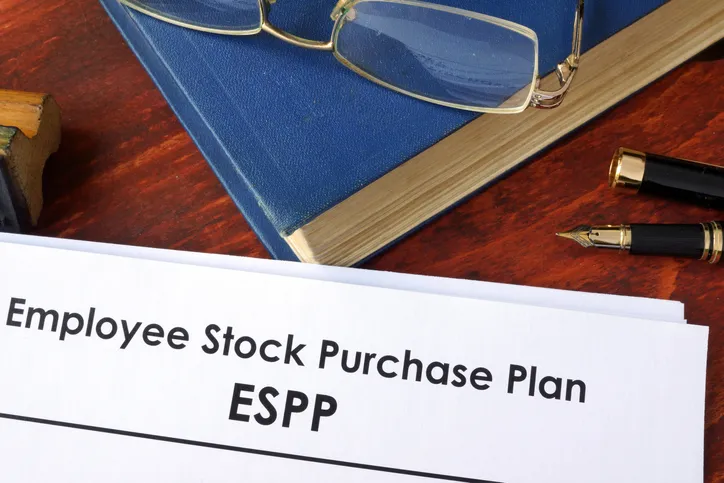An employee stock purchase plan (ESPP) qualifying disposition occurs when you meet certain IRS holding requirements before selling the stock you acquired through your company’s plan. Qualifying dispositions often get more favorable tax treatment than if you were to sell too soon, known as a disqualifying disposition. But the rules can be specific, and your strategy for holding or selling shares should consider factors like market performance, tax rates and diversification.
A financial advisor can help you decide when and how to sell ESPP shares as part of your overall investment and tax strategy.
An Overview of ESPPs and How They Work
An ESPP is a workplace benefit that allows employees to buy company stock, often at a discount, through payroll deductions. Many qualified ESPPs offer discounts of up to 15% off the stock’s market price. They also may include a “lookback” provision, which allows the purchase price to be based on the lower of the stock price at the beginning or end of the offering period.
There are two main types of ESPPs: qualified and non-qualified. A qualified ESPP follows IRS Section 423 rules, which makes it eligible for favorable tax treatment upon meeting certain requirements. This is where the concept of an ESPP qualifying disposition becomes important.
What Is an ESPP Qualifying Disposition?
An ESPP qualifying disposition refers to the sale of shares purchased through a qualified ESPP that meets specific IRS holding period requirements. If you meet these requirements, a portion of your gains are taxed at long-term capital gains rates, which are typically lower than ordinary income tax rates.
The alternative—a disqualifying disposition—occurs when you sell shares before meeting the required holding periods. In that case, more of your profit is taxed as ordinary income, which can be significantly higher depending on your tax bracket.
In simple terms:
- Qualifying disposition = meets holding period rules (resulting in more favorable tax treatment)
- Disqualifying disposition = sold too soon (can result in higher taxes)
IRS Holding Requirements for a Qualifying Disposition

The IRS has two rules that you must meet to achieve an ESPP qualifying disposition:
- Two years from the offering date. You must wait at least two years from the date your ESPP offering period began.
- One year from the purchase date. You must wait at least one year from the date the shares were actually purchased.
Here’s an example of what that would look like:
- Offering date: January 1, 2023
- Purchase date: December 31, 2023
- Earliest qualifying disposition date: January 1, 2025 (two years from offering date and one year from purchase date)
It’s important to track these dates carefully, as selling even a day early will result in a disqualifying disposition. Many investors set reminders or maintain a spreadsheet to avoid missing the qualifying window.
Tax Treatment of a Qualifying Disposition
One of the biggest advantages of an ESPP qualifying disposition is its favorable tax treatment. When you sell ESPP shares in a qualifying disposition, the discount you received at purchase (or the lower of the purchase price discount and gain from purchase date to sale date) is taxed as ordinary income. Any additional gain beyond that amount is taxed as long-term capital gain.
Let’s take a look at another example:
- Offering price: $20/share
- Purchase price (15% discount): $17/share
- Sale price: $30/share
In this example, the ordinary income portion would be the lower of either the discount based on the offering price ($3) times the number of shares, or the gain from the purchase price to the sale date ($13) times the number of shares.
For the long-term capital gain portion, any remaining profit after the ordinary income amount is subtracted.
This split can result in significant tax savings when compared with a disqualifying disposition, where a larger portion is taxed as ordinary income.
Tax Treatment of a Disqualifying Disposition
If you sell your ESPP shares before meeting the holding period requirements, the sale is considered a disqualifying disposition. In this case:
- The discount is always taxed as ordinary income.
- Any gain beyond that is taxed as short- or long-term capital gain, depending on how long you held the shares after purchase.
Short-term gains are taxed at your ordinary income tax rate, which is usually higher than the long-term capital gains rate.
However, in some situations, selling early might still make sense, such as if your company’s stock price drops or you want to reduce concentrated stock risk. In those cases, the benefit of preserving your investment value may outweigh the tax benefits of waiting for an ESPP qualifying disposition.
Strategies for Meeting Qualifying Disposition Requirements
If your goal is to benefit from an ESPP qualifying disposition, you’ll need to plan ahead. Here are steps to consider taking:
- Track all key dates. Keep a record of each offering and purchase date.
- Use reminders. Set calendar alerts for when shares become eligible for a qualifying disposition.
- Balance taxes with risk. Holding periods can expose you to market volatility, so weigh the potential tax savings against the possibility of a price drop.
- Diversify gradually. Consider selling shares as they reach qualifying disposition status to avoid having too much tied to your employer’s stock.
- Coordinate with other taxable events. If you’re already expecting high income in a particular year, you may want to defer your ESPP sale to a year with a lower tax bracket.
Common Mistakes to Avoid
Even seasoned investors can make mistakes that impact their ESPP tax outcome. The following are some common ones you’ll want to avoid:
- Accidentally selling too. Miscounting the holding period can turn what you thought was a qualifying disposition into a disqualifying one.
- Focusing only on taxes. Sometimes it’s worth selling early to manage portfolio risk.
- Failing to diversify. Concentrating too much wealth in company stock can be risky, even if it’s in a qualifying disposition window.
- Not integrating ESPP sales into your financial plan. ESPP shares should serve as part of your broader investment, retirement and tax strategy.
Bottom Line

An ESPP qualifying disposition can significantly reduce the taxes you owe when you sell shares from your company’s employee stock purchase plan. By holding your shares for at least two years from the offering date and one year from the purchase date, you unlock more favorable long-term capital gains tax treatment. A financial advisor can help you map out an ESPP strategy, including tracking dates, analyzing tax implications and integrating your stock sales into your broader wealth plan.
Investment Planning Tips
- A financial advisor can help you pick and manage investments for your portfolio. Finding a financial advisor doesn’t have to be hard. SmartAsset’s free tool matches you with vetted financial advisors who serve your area, and you can have a free introductory call with your advisor matches to decide which one you feel is right for you. If you’re ready to find an advisor who can help you achieve your financial goals, get started now.
- If you want to diversify your portfolio, here’s a roundup of 13 investments to consider.
Photo credit: ©iStock.com/designer491, ©iStock.com/David Gyung, ©iStock.com/Wasan Tita
